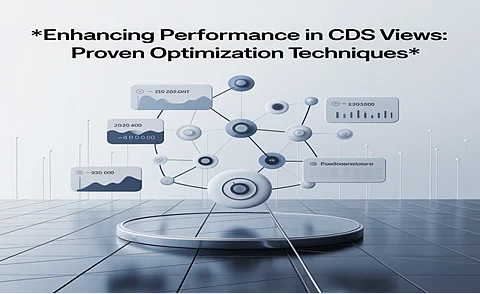

In today’s world, Sravanthi Beereddy, a technologist with expertise in SAP systems architecture, delivers a deeply technical but practical exploration into optimizing ABAP Core Data Services (CDS) views. In this article, she dissects the multi-layered landscape of performance enhancement within SAP applications—shifting the focus from theoretical best practices to measurable system gains.
At the heart of Beereddy’s analysis lies the Code-to-Data paradigm—a transformative concept that shifts data processing responsibilities from the application server to the database layer. This change isn't merely structural; it's foundational. By eliminating excessive data transfers and capitalizing on in-memory processing, CDS views dramatically reduce CPU usage and network latency. This architecture allows SAP HANA to process logic closer to the data, leading to results like a 94% reduction in network traffic and an 84% decrease in report generation time.
The technical enhancements are not just anecdotal—they are clearly quantifiable and backed by empirical evidence. Beereddy’s in-depth comparisons between traditional ABAP coding and optimized CDS view implementations demonstrate staggering performance improvements: query execution times are reduced by an impressive 83–86% across a range of common enterprise reporting scenarios. These findings are further substantiated by comprehensive visual execution plans and detailed metric tables (refer to page 2 and 4), which highlight how CDS views fully leverage SAP HANA’s advanced capabilities such as parallel processing, columnar data storage, and predicate pushdown mechanisms for maximum efficiency.
A significant portion of performance tuning comes from rethinking joins and filters. The shift from indiscriminate outer joins to precision inner joins, when logically sound, trims both processing time and memory use. Similarly, repositioning filters from the application layer into the earliest stages of the query—directly within the CDS views—allows for immediate data pruning. As showcased in examples on pages 4 to 12, this practice can reduce processed record volumes by over 90%, which translates into leaner, faster applications.
Beereddy emphasizes the transformative power of annotations—not as mere decorative metadata, but as critical performance directives for the SAP HANA optimizer. By explicitly tagging measures, dimensions, aggregation strategies, and semantic intents, developers provide crucial guidance that directly influences the optimizer’s execution path selection and runtime decisions. With carefully optimized annotations, analytical query execution times improved by up to an impressive 87%. Beyond raw speed enhancements, these annotations also facilitate advanced semantic modeling, improve maintainability, and significantly streamline seamless integration with front-end analytical tools, dashboards, and BI platforms for end users.
Nested logic and redundant operations are another hidden source of inefficiency. Beereddy recommends breaking down complex CASE statements and favoring UNION ALL over UNION when duplicates aren’t a concern. These modifications—often subtle in code—yield dramatic performance gains. Her optimized examples reveal a 76% drop in execution time and a 59% cut in CPU load, proving that even logical expressions require strategic design.
Beereddy's analysis moves beyond the data layer and dives into ABAP code enhancements. She urges developers to abandon direct table access in favor of using CDS views via DDL names. This simple abstraction not only improves maintainability but reduces code size, roundtrips, and execution time. Moreover, selecting only essential attributes instead of defaulting to SELECT * leads to a 95% drop in data transfer volume—a crucial factor in high-load systems.
No optimization effort is truly complete without a dedicated focus on enhancing the end-user experience. In the later sections of her comprehensive work, Beereddy introduces a range of UI5 performance improvements, including asynchronous processing, lazy-loading UI components, intelligent data prefetching, and dynamic visual feedback indicators. These best practices don’t merely reduce front-end load times—they fundamentally reshape how users perceive system speed and interactivity. As demonstrated in the case of asynchronous processing (pages 34–36), UI responsiveness effectively doubled, while user satisfaction scores significantly increased—even in scenarios where backend system performance metrics remained unchanged.
In conclusion, by weaving together best practices from the database layer to the front-end, Sravanthi Beereddy presents a holistic approach to SAP performance optimization. Her work isn’t merely academic—it’s a blueprint for scalable, responsive, and future-proof enterprise systems. In concluding her comprehensive guide, Beereddy underscores the importance of continuous performance monitoring, disciplined architecture, and a readiness to rethink traditional patterns.
